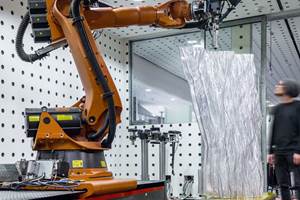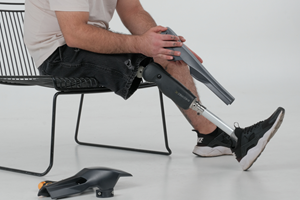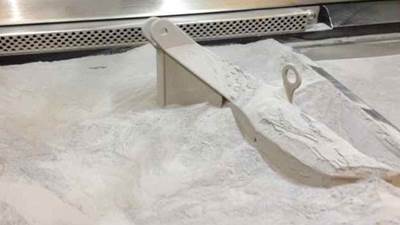Materialise Adopts New Materials to Expand its Manufacturing Service Offerings
By expanding its manufacturing service offerings with PA 11, PA 12S and PA-CF materials, Materialise aims to meet the evolving needs of its customers.
Materialise has expanded its additive manufacturing (AM) portfolio with the introduction of Polyamide 12S (PA 12S), Polyamide 11 (PA 11) for Multi Jet Fusion and Carbon Fiber Reinforced Polyamide (PA-CF) for fused deposition modeling (FDM). The company says this expansion is part of its efforts to empower companies across industries to leverage 3D printing for serial production and prototyping. With these additions, Materialise now offers more than 38 materials, providing customers with an broad selection to meet their specific project requirements.
The company says the global adoption of 3D printing has been accelerating rapidly in recent years, transforming traditional manufacturing processes and unlocking new possibilities in product development, customization and supply chain management. Businesses seeking to innovate and stay competitive in today's fast-paced market landscape require reliable partners that offer a broad portfolio and deliver consistent part quality.
“Our decision to incorporate PA 11, PA 12S and PA-CF materials into our portfolio reflects our commitment to meeting the evolving needs of our customers and empowering them to explore new possibilities and unlock the full potential of industrial 3D printing,” says Pieter Vos, Materialise marketing and product director. “We constantly evaluate emerging materials and technologies. The new HP PA 12S is a strong addition and we are proud to be an early adopter."
By expanding its manufacturing service offerings with PA 11, PA 12S and PA-CF materials, Materialise aims to to drive innovation and accessibility in the field of industrial 3D printing, supporting businesses in realizing their applications and accelerating the adoption of AM for serial production and prototyping across various industries. The new materials offer a range of benefits, including exceptional mechanical properties, durability, and versatility, making them well suited for a diverse range of industrial applications across various sectors.
Enabling Medical Technology Sector With PA 11
One of the key advantages of incorporating PA 11 for HP Multi Jet Fusion is the ability to address the growing demand for AM in the medical technology sector. The material offers unique properties that make it well suited for various medical technology applications with 3D printing. Its biocompatibility, durability and flexibility enable the production of orthotics, prosthetics and machinery components with exceptional performance and reliability.
Supporting Volume Prototyping Through Early Adoption of HP PA 12S
Materialise Manufacturing says it is among the first adopters of Polyamide 12S for HP Multi Jet Fusion. The material presents itself as a strong option for volume prototyping and parts requiring good surface quality with minimal postprocessing needs. Its high level of detail and dimensional accuracy make it suitable for various applications in consumer goods, industrial settings and volume prototyping projects.
PA-CF: Strong And Lightweight for Industrial Applications
It is said Carbon Fiber Reinforced Polyamide (PA-CF) for FDM is a notable advancement for lightweight, high-strength components. Consisting of a thermoplastic filament reinforced with 35% chopped carbon fiber by weight, PA-CF offers exceptional flexural strength, leading to an impressive stiffness-to-weight ratio. This combination makes it a favorable alternative to heavier metal components in industries such as industrial machinery, aerospace and automotive, particularly for tooling, prototyping, and end-use part applications.
Related Content
3D Printing Brings Sustainability, Accessibility to Glass Manufacturing
Australian startup Maple Glass Printing has developed a process for extruding glass into artwork, lab implements and architectural elements. Along the way, the company has also found more efficient ways of recycling this material.
Read MoreUltiMaker Targets Light Industrial Applications With 3D Printer Designed for the Factory Floor
The company’s Factor 4 3D printer introduced this week is designed to complement conventional manufacturing equipment including CNC machining and automation.
Read MoreMedical Molder Relies on 3D Printing to Speed Development of Inspection Fixtures
Medical molder Medbio uses FFF and SLA 3D printers in designing (and sometimes producing) its inspection fixtures.
Read MoreIn Armenia, Personalized 3D Printed Shields Improve Fit for Prosthetics
The ongoing conflict in Armenia has left many of its citizens sustaining injuries, especially the loss of limbs. With difficulty in accessing quality health care, many people have poorly fitted prosthetics. The solution lies in 3D modeling and printing customizable prosthetic case covers enabling better healing outcomes and comfort for patients.
Read MoreRead Next
Postprocessing Steps and Costs for Metal 3D Printing
When your metal part is done 3D printing, you just pull it out of the machine and start using it, right? Not exactly.
Read MoreProfilometry-Based Indentation Plastometry (PIP) as an Alternative to Standard Tensile Testing
UK-based Plastometrex offers a benchtop testing device utilizing PIP to quickly and easily analyze the yield strength, tensile strength and uniform elongation of samples and even printed parts. The solution is particularly useful for additive manufacturing.
Read MoreCrushable Lattices: The Lightweight Structures That Will Protect an Interplanetary Payload
NASA uses laser powder bed fusion plus chemical etching to create the lattice forms engineered to keep Mars rocks safe during a crash landing on Earth.
Read More





















